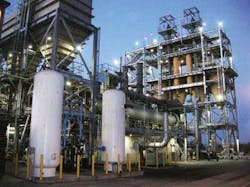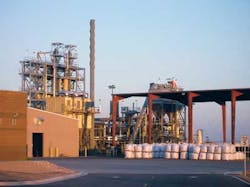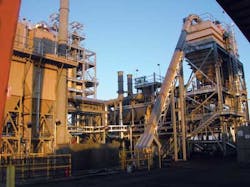By Mike Dahm and Leo Zappa
Producing water fit to drink involves the use of natural resources and energy. Advanced treatment processes such as membrane filtration, ultraviolet (UV) disinfection and ozone treatment use large amounts of energy to operate. With environmental responsibility increasingly at the forefront of the water and wastewater industry, municipalities and private water utilities across the U.S. are considering new best practices when reviewing their water treatment processes.
One advanced treatment process being impacted by this approach is granular activated carbon (GAC) filtration. GAC has been used for decades to remove organic compounds from water and wastewater and to improve taste and odor (T&O) for drinking water. Recently, the technology has seen an increase in use, primarily due to its effectiveness in reducing the formation of disinfection byproducts (DBPs), which are carcinogenic compounds regulated by the EPA.
The manufacturing and use of GAC requires energy to extract and transport the raw material - coal - from the mines to the GAC production facilities, and again to move the finished product to the treatment plant. Until recently, it was common practice to dispose of the used GAC once it reached its capacity to adsorb the targeted organic compounds. The increased use of GAC to reduce DBP formation has prompted efforts to address the costs and sustainability of the technology. Driven by the need to maximize the economic and environmental viability of GAC, the industry has shifted to its reuse and reactivation through custom reactivation.
How It Works
GAC works on the principle of adsorption, whereby molecular organic compounds found in water are trapped within the structure of the GAC particles as the water passes through the media. These particles are small but possess a large amount of storage volume due to the multiplicity of cracks and crevices within each particle. While GAC's capacity to adsorb various chemicals is significant, eventually the carbon's structure will get filled and the GAC will need to be replaced. Originally, once exhausted, the GAC was removed and either landfilled or incinerated, and the filters were loaded with new carbon. This required the mining and transport of more coal, use of more energy to produce GAC, and transportation of the finished product to the treatment plant. Of these production steps, the mining and transport of the coal generate the most expense and greenhouse gas emissions (GHG) in the process.
In the mid-2000s, the concept of custom reactivation of GAC began to take hold in the American municipal water treatment industry. This was largely driven by the fact that the DBP regulatory compliance application was expected to require relatively frequent exchanges of GAC, which was estimated to be between 12 and 24 months on average. This exchange frequency, combined with the very large amounts of GAC expected to be installed at water plants using carbon to treat for DBPs, led municipal utilities and consulting engineers to consider other options for managing their GAC systems. The process of reactivation was found to have a number of benefits.
Reactivation of exhausted carbon can be accomplished by using a thermal process similar to the process used to convert coal into new GAC. The compounds that have been captured in the GAC structure are destroyed after being subjected to high temperatures, thereby restoring the carbon's adsorptive capacity. A small amount of new GAC is added to the reactivated carbon to make up for losses in the reactivation process - between 10 and 20% - known as "make-up" carbon.
Since the majority of the energy consumption and GHG emissions associated with GAC production are in the initial coal-mining step, the equivalent quantity of custom reactivated GAC carries only 20% of the GHG emissions than new GAC. Reactivating carbon is also less expensive than producing new GAC since, other than providing the small amount of new make-up GAC, the only cost input is natural gas for the thermal process. As a result, custom-reactivated carbon can be delivered for 20 to 40% less cost than new GAC.
Beyond the savings in money and GHG emissions, the switch to reactivated carbon was also looked upon as a means of providing a secure supply of GAC for municipalities and as being environmentally responsible. It was realized that by switching to reactivated GAC, utilities would possess 80 to 90% of their GAC at any time, so they would be less vulnerable to fluctuations in its supply and cost. They would also eliminate the practices of landfilling or incinerating spent activated carbon.
Custom Reactivation Comes to the Southwest
Perhaps no region better exemplifies this approach to using GAC than the greater Phoenix, Ariz., area. Faced with meeting EPA's new Stage-2 Disinfection Byproduct Rule, the cities of Phoenix, Scottsdale and Glendale, working in conjunction with their engineering consultants, settled on GAC for Stage-2 compliance. However, there were concerns regarding the cost and environmental impacts of using large quantities of it. Between the three cities, approximately 30 million pounds of GAC would be needed. Based on engineering estimates, this carbon might need to be exchanged every six to 24 months. It was feared that the cost would be prohibitive, and the thought of attempting to landfill this much GAC each year was an environmental nightmare.
At this point, the cities and their consultants began to consider custom reactivation as a means of mitigating these perceived drawbacks to GAC adoption. An engineering study indicated the potential cost savings and environmental benefits of adopting this approach for the planned GAC treatment systems. The communities then collaborated on a joint procurement strategy allowing them to identify and qualify a number of vendors who could provide the required services.
One important point decided upon in the strategy was the need for the vendor to construct a custom-reactivation facility local to the Phoenix area. This would limit costs and scheduling delays associated with transportation between the water plants and the reactivation facility, as well as minimize the environmental impact associated with the transportation of large amounts of GAC. Establishing this facility was also seen as an important means of stimulating the local economy.
Between 2009 and 2012, the three cities executed their strategy and managed the procurement process, which resulted in the selection of Calgon Carbon Corporation as the vendor to provide custom-reactivation services and build a local reactivation facility. Once the contract was awarded, Calgon faced the task of building a brand new facility under a tight schedule. Aided by local government officials, a suitable site was located in the town of Gila Bend, some 70 miles to the southwest of Phoenix. Construction was fast-tracked, and the facility was completed in approximately one year, opening for operation in April 2013 - two months ahead of schedule.
Sustainable and eco-friendly considerations were at the forefront of the design of the Gila Bend reactivation plant. It was designed around the use of rotary kilns for the thermal reactivation of the spent GAC. Rotary kilns are more energy-efficient than multi-hearth furnaces - the other commonly-used reactivation technology. The product cooling system was designed around a new air-cooled process - a departure from the industry-standard, water-jacketed cooling screws.This decision was made to reduce the plant's water footprint, which made sense given its location in the middle of the Sonoran Desert.
The pollution abatement system was also designed with water conservation in mind. Ordinarily, a wet scrubber system would have been used to capture volatile compounds produced by the GAC reactivation process. However, to minimize the plant's ecological impact, a water-free, high-temperature dust collector was chosen instead. Other steps taken to make the new plant sustainable included incorporating a waste-heat recovery system, which produced a 20% reduction in natural gas usage, as well as LED lights throughout the facility, which reduced the electrical load.
The initiatives taken by the cities of Phoenix, Scottsdale and Glendale resulted in GAC use via custom reactivation, saving them over 40% in cost versus replacing their GAC with new carbon upon its exhaustion. Finally, the local reactivation facility was designed with sustainable and eco-friendly operation as a prime feature. The Phoenix region and the Gila Bend reactivation facility represent a pioneering effort in applying GAC in a manner that maximizes its economic and ecologic benefits.
About the Authors: Mike Dahm is the manager of project engineering for Calgon's Facilities Engineering group. He has 12 years' experience with Calgon in manufacturing plant capital investment improvements and maintenance management. Leo Zappa is the director of marketing for Calgon's Municipal Business Unit. He has served in various engineering, sales and marketing positions within Calgon for over 23 years.






